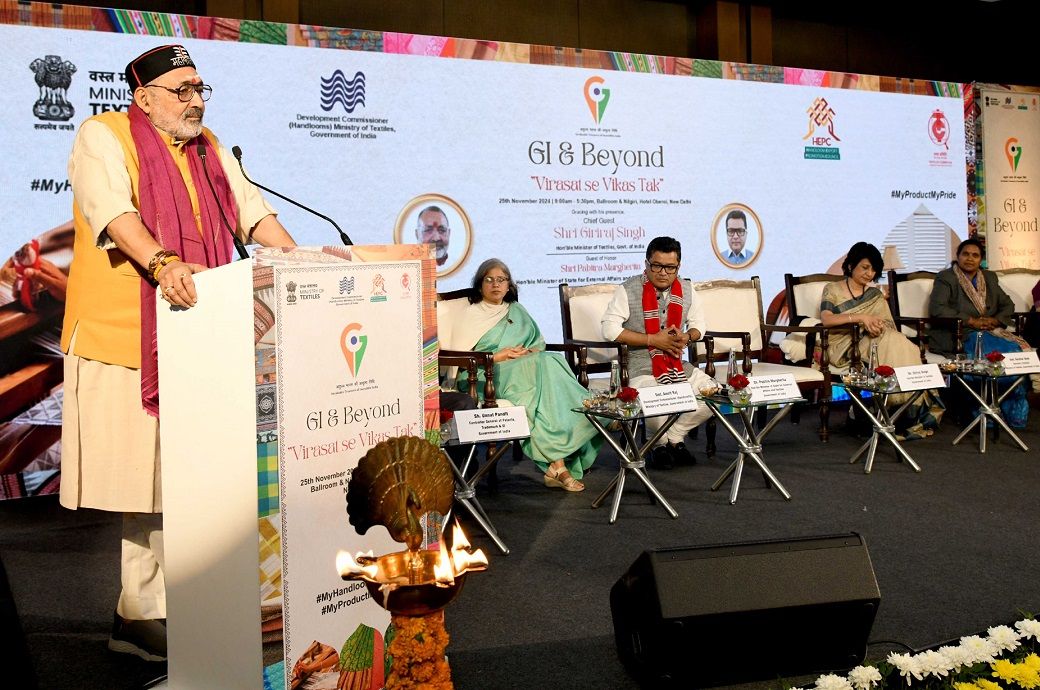The ‘GI & Beyond 2024’ Summit, organised by the Office of the Development Commissioner for Handlooms under the Indian Ministry of Textiles, in collaboration with the Handloom Export Promotion Council (HEPC), concluded on November 25, 2024, in New Delhi.
The ‘GI & Beyond 2024’ Summit, held in New Delhi, focused on promoting India’s GI-tagged handloom and handicraft products.
Inaugurated by Indian Minister of Textiles Giriraj Singh, the event emphasised expanding GI products from ‘Gaon to Global.’
The Minister highlighted the importance of increasing artisans’ income and making these products globally recognised.
The summit was inaugurated by Giriraj Singh, the Indian Minister of Textiles. During his address, the Minister distributed GI (geographical indication) certificates to 10 artisans from various parts of the country and noted that India received its first GI certification in 2004. He emphasised that the current focus is on increasing the income of artisans and making GI-tagged products more globally recognised.
He urged attendees to expand GI products from ‘Gaon to Global’ and stressed the importance of marketing to promote these products, incorporating them as a part of religious and cultural tourism. The Minister also appealed to states with GI-tagged products to collaborate with the Textiles Ministry to organise trade festivals exclusively for promoting and marketing these products, similar to the Kutch festival.
Giriraj Singh highlighted the Indian Prime Minister’s vision of Atmanirbhar Bharat and emphasised that, along with development (Vikas), we also need to preserve our heritage (Virasat). The GI tag represents our heritage, and as we move towards a developed Bharat (Vikasit Bharat), our heritage remains our capital, the Minister added.
Pabitra Margherita, Minister of State (MoS) for Textiles, Government of India, also attended the event as the guest of honour. He highlighted that the handloom and handicraft sectors are not merely industries but embodiments of India’s diversity, creativity, and legacy. The GI tag, he said, serves as a tool for empowerment and a bridge to global markets.
The event saw participation from 13 countries across four continents, with around 20 overseas buyers, 50 exporters, and multinational corporations, alongside 70 GI authorised users and 40 officials from various state governments. The diverse international representation facilitated meaningful discussions and collaborations to expand the market potential for GI-tagged products, Ministry of Textiles said in a press release.
The technical session focused on integrating traditional handwoven and handcrafted skills with modern business practices, enhancing the global appeal of India’s textiles and crafts.
During the event, overseas buyers and domestic exporters interacted with authorised users of GI products. Overseas attendees praised the summit for narrating India’s traditional craftsmanship beautifully, while domestic exporters noted that the products on display were impressive and captivating. Both groups expressed their willingness to extend support to enhance the global presence of GI products.
A special thematic display showcased an impressive array of GI-tagged handloom and handicraft products, demonstrating the regional uniqueness and cultural value of these products. Attendees were captivated by the display, which highlighted the stories and traditions behind each craft.
The event concluded with a collective commitment to continue supporting the Indian handloom and handicraft sectors, ensuring that the legacy of GI products thrives both nationally and internationally.
Fibre2Fashion News Desk (HU)


